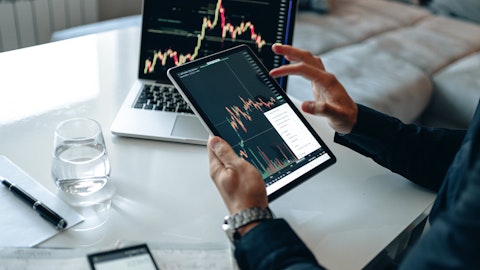Irene Rummelhoff: First of all, I think you noticed that our CEO is becoming an expert on the gas market for very good reasons. So I don’t have a tremendous amount of insight to add. But I think for 2024, the weather scenario has sort of played out. We think this winter, as the last year’s winter are going to be among the top five warmest winters in the last 60 years of history or something. So – and we’ll go out of this winter season with storage at approximately 55% level. So we’re sort of good for 2024. What we need to watch is what Anders rightly pointed out, it’s a demand recovery. We’ve seen some positive signs. But even more important, the demand recovery or growth in Asia. LNG is clearly going to be the price setter for the gas market in the foreseeable future.
And the growth in Asia is significantly bigger than what we can expect in Asia. We’re going to run into a period, I guess, in 2026, 2027 with a lot of new LNG coming to the market from Qatar and the U.S. It’s a bit of a tough period, I think, for the gas market. And there is some nervousness around that period, which we also indicate, I guess, in the material that we have presented to you. And then, of course, there’s a Biden decision to pause LNG projects. It’s hard to say what really the underlying driver for that decision is, but we do expect that there will be a real pause and there will be a delay in some of the projects that are meant to come in to the market and an oversupply period, they will come a little bit later and probably match demand better.
So all in all, I think the outcome of that is not too bad for the global supply-demand balances.
Kjetil Hove: Yes, I could cover a bit on the NCS. Our outlook for 2035 on the NCS is basically built on three pillars. It’s the huge project portfolio, which I talked about, more than 50 projects. That’s the main chunk of the outlook for towards 2035. But then on the increased recovery, yes, we have been able to lift it from 30 to 50 on the average, but there is still potential there. So we see that every year are able to mature at least 50 to 70 wells to be drilled on the NCS, and we expect to deliver that this decade as well. So yes, we have lifted it to 50, but it still is quite a huge potential left on recovery. On the exploration and ILX, we have just started. We see that we consistently are able to deliver from our ILX portfolio.
Last year, we had 12 discoveries, and we expect that, that we should be able to continue with. And we see, based on the new technology that we utilize that we see these smaller pockets much better than we did just a couple of years ago. So it’s based on what we have been able to achieve the last 10 and what 10 years and what we are able to see in the seismic. So we have just started on the ILX on the [indiscernible].
Bard Glad Pedersen: Very good. Thank you very much. Let’s take Teodor’s question, no. If you could keep your hands up a little bit, better, yes. Please go.
Teodor Sveen-Nilsen: Yes. Teodor Sveen-Nilsen of Sparebank 1 Markets. First, on the balance sheet, still very strong 22% net cash – capital employed. And you said Torgrim that you expect to have net cash flow zero net cash by year-end, but that’s still not a long-term guidance of 15% to 30% net debt to capital employed. So why do you spend so long time to get the balance sheet in sync with your official guidance? First question. And the second question is looking back to the Capital Markets update last year. Key message was that you wanted to focus on value over volume. Now you decided that you will invest in Empire Wind at 4% IRR. Why has the volume become more important than value the past 12 months?
Anders Opedal: You can start with the net debt ratio.
Torgrim Reitan: Okay. Thanks, Teodor. So in 2023, we planned for a negative cash flow of $8 billion, and it actually ended with a negative cash flow $8 billion for the year. With the program for this year, we’re actually planning for a negative free cash flow of minus $10 billion, if you do the math, which is actually going to bring the net debt to a positive territory. So this is actually a very rapid direction towards a different and more efficient capital structure. The 15% to 30% net debt is not sort of a target in itself. It is a guiding on what we find is a natural level and a good capital structure for a company like ours. We have operated above and below for many, many years. Over time, we want to move in that direction.
And with the $8 billion to $10 billion capital distribution we suggest for next year, it will move sort of in that direction. Then I just want to remind us that we are living in a very, very volatile world. We had our best results in 2022, and we had our worst results in 2020, and we need to be prepared for that. So I am okay and happy to operate below that range. But clearly, we want to move towards it over time.
Anders Opedal: And to be very clear, value over volume is still our guidance, both for oil and gas and also for renewables. Moving forward with Empire after the deal we did with BP is what we see is creating the best value for Equinor. We are within the guidance range both on forward-looking, but also on the fuel cycles, if we take into account the recent transactions we have done there. Now we’re waiting for the results from the bid, as Torgrim said. And we will, at the right time, find another partner and we will project finance this. And as Hege also alluded to you on Dogger Bank and are working on increasing the lifetime of offshore wind park. So we will create more and more value over time as well. So this is the best way we can create value from the Empire project in our mind.
Bard Glad Pedersen: Very good. Next one is Chris Kuplent, Bank of America. Then afterwards, we take one on the line.
Christopher Kuplent: Thank you very much. I’ve got two questions probably both for you, Torgrim. And you can categorize them under the topic of cash flow cushions. And I want to look back a little bit. You said in your remarks that the $20 billion CFFO for 2023, came in line with what you told us about 12 months ago, which is true. But I think 12 months ago, you were expecting production growth to be 3% in 2023. You were, I think, using $20 per MBtu of gas price assumptions, certainly a level that we didn’t see in 2023. So I wonder how much contingency was included or maybe you can give us a little bit of a bridge in terms of pluses and minuses why you nevertheless ended up at 20 billion CFFO. And the second question that I’m keen on talking about is on CapEx. Empire Wind, you highlighted is now included for 2024 at $1.2 billion.
And that means if I take that out, the CapEx, $13 billion, minus $1.2 billion looks like, again, towards the very low end of your previous CapEx guidance. So maybe you can tell us whether there were some project slippage that pushed CapEx perhaps further to the right as well?
Torgrim Reitan: Okay. Thanks, Chris. Thank you for the detailed question on 2023 because it gives me an opportunity to give a little bit more color to it, because it was 19.7% as we reported. If we sort of apply the price assumptions that we used, it would have been 20.5%. So it actually like-for-like, it would have been 20.5%. And then there has been some slippage in some of the production during the year. So I mean, in general terms, when we put forward numbers, clearly, they are very important to us. We commit to them. And then we want to remain sure that we can deliver. So there will always be a certain time or a certain part of [indiscernible] what we put forward. That is just the way companies work. The second point is the CapEx…
Anders Opedal: And you rightly say, we around 11.8%. And then last year, we said 13% but back-end loaded. So we are actually very close to what we indicated last year with 13% back-end loaded and 11.8% now. So there is not necessarily kind of any particular project slippage into this. Actually, the guided CapEx last year and this year is in line with each other when you take away the Empire.
Bard Glad Pedersen: Let’s take one question on the line, please.
Operator: Biraj Borkhataria from RBC. Please go ahead.
Biraj Borkhataria: Hi. Thanks for taking my question. Sorry, I can’t do that. So my first question is just following up on Empire Wind. Your CapEx guidance, you said, does not assume the project financing. Could you just give some details on where you’d expect that to be finalized? And broadly speaking, what proportion of the CapEx that you typically project finance for Wind? And then the second question is on M&A and inorganic opportunities. A few years ago, you put out plans to effectively simplify your international portfolio and exit from the tail. But there’s been some interesting and exciting exploration success in places like Namibia and you’ll see players there that may be underfunded. So I was wondering your thoughts on your willingness to look at inorganic opportunities outside of the three key countries and the international portfolio you’ve highlighted in the past? Thank you.
Anders Opedal: Okay. I had a little bit difficult…





